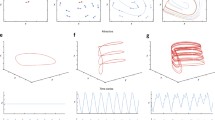Abstract.
This review combines short presentations of several mathematical approaches that conceptualize issues in sensorimotor neuroscience from different perspectives and levels of analysis. The intricate organization of neural structures and sensorimotor performance calls for characterization using a variety of mathematical approaches. This review points out the prospects for mathematical neuroscience: in addition to computational approaches, there is a wide variety of mathematical approaches that provide insight into the organization of neural systems. By starting from the perspective that provides the greatest clarity, a mathematical approach avoids specificity that is inaccurate in characterizing the inherent biological organization. Approaches presented include the mathematics of ordered structures, motion-phase space, subject-coincident coordinates, equivalence classes, topological biodynamics, rhythm space metric, and conditional dynamics. Issues considered in this paper include unification of levels of analysis, response equivalence, convergence, relationship of physics to motor control, support of rhythms, state transitions, and focussing on low-dimensional subspaces of a high-dimensional sensorimotor space.
Similar content being viewed by others
Author information
Authors and Affiliations
Additional information
Received: 28 August 2001 / Accepted in revised form: 11 July 2002
Correspondence to: e-mail: mccollum@ohsu.edu
Acknowledgements. I would like to express many thanks for the critical comments on this review offered by William L. Bloch, Jan E. Holly, Gerhard Magnus, and Patrick D. Roberts.
Rights and permissions
About this article
Cite this article
McCollum, G. Mathematics reflecting sensorimotor organization. Biol. Cybern. 88, 108–128 (2003). https://doi.org/10.1007/s00422-002-0344-z
Issue Date:
DOI: https://doi.org/10.1007/s00422-002-0344-z




